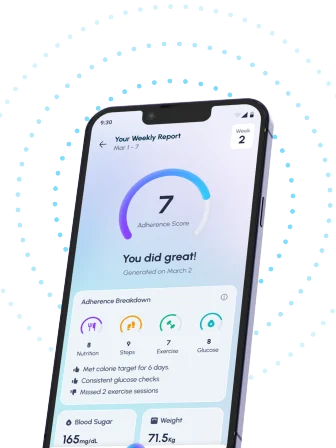Table of Contents
- Understanding and Managing the Dawn Phenomenon
- Practical Strategies to Control Dawn Phenomenon Blood Sugar
- Conquering Dawn Phenomenon: A Guide to Better Blood Sugar Control
- Is the Dawn Phenomenon Affecting Your Blood Sugar? Find Out Now!
- Dawn Phenomenon vs. Somogyi Effect: What’s the Difference?
- Frequently Asked Questions
- References
Are you waking up with higher-than-normal blood sugar levels, despite careful management throughout the day? You’re not alone. Many people with diabetes struggle with the dawn phenomenon, a frustrating rise in blood glucose that occurs between 5 am and 8 am. This blog post is dedicated to helping you understand and conquer the dawn phenomenon: we’ll explore practical strategies for better blood sugar control, empowering you to take back control of your mornings and your overall health. Let’s dive into the solutions that can finally help you achieve more stable blood sugar levels.
Understanding and Managing the Dawn Phenomenon
The dawn phenomenon – that frustrating pre-breakfast blood sugar spike – is a significant hurdle for many people managing diabetes, especially in regions like India and other tropical countries. With youth-onset diabetes rising by 4% annually in Indian urban areas, understanding and managing this early morning glucose surge is more crucial than ever. Think of it like this: your body’s natural alarm clock is a little off-kilter, leading to higher blood sugar levels before you even start your day.
Recognizing the Dawn Phenomenon
This isn’t just about overnight fasting. It’s a hormonal tango. As you sleep, your body releases hormones like cortisol and growth hormone, which naturally boost glucose production in your liver. In people with diabetes, this effect is often amplified because insulin’s ability to regulate blood sugar isn’t as effective. The tell-tale sign? Higher blood glucose levels in the morning, even if your evening insulin dose seemed perfectly fine.
Strategies for Effective Management
Tackling the dawn phenomenon needs a personalized approach. Fine-tuning your insulin timing and dosage is key. This might involve adjusting your evening insulin to later in the night – but always discuss this with your doctor or certified diabetes educator (CDE). Regular blood glucose monitoring, especially before breakfast, is critical for tracking how your body responds to any changes. And remember, healthy eating plays a huge role; incorporating things like dates (check out this link for more info) as part of a balanced diet can make a difference.
Finding Support in India and Tropical Climates
Living in a tropical climate adds another layer of complexity. Heat and humidity can impact blood sugar levels, so consistent monitoring and close communication with healthcare professionals who understand these local factors are vital. Lean on local diabetes support groups and CDEs familiar with the challenges of managing diabetes in your specific region. Remember, effective diabetes management is an ongoing journey, and actively addressing the dawn phenomenon is a powerful step toward better health.
Practical Strategies to Control Dawn Phenomenon Blood Sugar
Understanding the Dawn Phenomenon in Tropical Climates
The dawn phenomenon—that frustrating blood sugar spike between 5 am and 8 am—hits many of us hard, especially in warmer climates like India. Even with a solid nighttime insulin routine, this early morning rise can be a real challenge. Think of it like this: your body’s natural rhythms are working against you. Remember, a fasting blood sugar under 140 mg/dL is generally fine, 140–199 mg/dL suggests prediabetes, and 200 mg/dL or higher points to diabetes. Knowing these numbers is your first step to better control.
Actionable Steps for Better Control
So, what can you do? First, talk to your doctor about adjusting your evening insulin. A smaller, later dose of long-acting insulin, or perhaps a completely different insulin regimen, might make all the difference. Dietary tweaks are equally important. Avoid heavy carbs before bed; a lighter snack with some protein or a small portion of complex carbohydrates might be a better choice. Even a short walk can work wonders, improving your body’s sensitivity to insulin. For quicker solutions to high blood sugar, check out our blog on 10 Tips for Immediate Blood Sugar Reduction – Tap Health.
Regional Considerations
In India and other tropical regions, the heat and humidity can add another layer of complexity. Staying well-hydrated throughout the day is crucial. And this is where a diabetes specialist familiar with the local challenges becomes invaluable. They can personalize a plan that accounts for your unique needs and the specific climate you live in. Ultimately, consistent monitoring and proactive management are your best weapons against the dawn phenomenon. Want to learn more about why morning blood sugar spikes happen in general? Read our article, Why Blood Sugar Spikes in the Morning and How to Manage Them.
Conquering Dawn Phenomenon: A Guide to Better Blood Sugar Control
Understanding the Dawn Phenomenon in Tropical Climates
The dawn phenomenon—that frustrating blood sugar spike between 5 am and 8 am, even if you haven’t eaten—is a common challenge, especially in warmer climates like India. Imagine this: you’ve meticulously managed your blood sugar all day, aiming for that ideal pre-meal range of 80–130 mg/dL and under 180 mg/dL after meals, only to wake up to higher-than-expected levels. The heat and humidity in tropical regions can make existing metabolic issues worse, potentially amplifying this morning rise.
Practical Strategies for Blood Sugar Control
Tackling the dawn phenomenon needs a multi-faceted approach.
- First, talk to your doctor about adjusting your medication. A longer-acting insulin or a tweak to your current meds might provide better overnight control.
- Second, diet plays a huge role. A light dinner several hours before bed, focusing on complex carbohydrates and avoiding sugary treats, is key. Think a small portion of brown rice with vegetables, rather than a bowl of sugary cereal.
- Finally, regular exercise, especially in the early evening, can improve insulin sensitivity, helping to lessen the dawn effect.
Regional Considerations for Effective Management
In India and other tropical countries, lifestyle plays a significant role. The readily available high-carbohydrate foods in many regions can easily contribute to elevated blood glucose levels, worsening the dawn phenomenon. Some people find that incorporating elements of Ayurvedic practices, always under a qualified practitioner’s guidance, can offer additional support. This might include specific dietary adjustments or herbal remedies—but remember, always discuss this with your doctor first.
Taking Control of Your Blood Sugar
Regular monitoring, especially those early morning checks, is crucial. Work closely with your endocrinologist or doctor to create a personalized plan. Taking charge of the dawn phenomenon is a significant step toward better overall health and well-being. Consistent effort and medical guidance are your best allies.
For more tips on building helpful habits and managing diabetes as you age, check out our guides: How to Build Habits That Help Control Blood Sugar Levels and Managing Diabetes as You Age: Challenges and Solutions.
Is the Dawn Phenomenon Affecting Your Blood Sugar? Find Out Now!
Waking up with higher blood sugar than when you went to bed? Even if you’ve diligently managed your diabetes all day, this frustrating experience—especially common in warmer climates like India—could be the dawn phenomenon. It’s different from the Somogyi effect (where low blood sugar triggers a rebound). Instead, the dawn phenomenon is your body’s natural increase in hormones like cortisol and glucagon during the early morning hours, leading to higher fasting blood glucose. A normal fasting blood sugar is 70–99 mg/dL. But consistently seeing levels above 100–125 mg/dL might signal prediabetes, and 126 mg/dL or higher suggests diabetes.
Understanding the Dawn Phenomenon in Tropical Climates
The heat and humidity of many tropical regions, including India, can worsen the dawn phenomenon. Think of it like this: your body already works harder to regulate temperature in the heat, adding another layer of challenge to blood sugar control. Add to that irregular sleep patterns (who hasn’t experienced that with a busy life?) and dietary habits influenced by regional cuisine, and consistent monitoring becomes even more crucial. Regular blood sugar checks before breakfast are key to understanding your body’s response and adjusting your management. Learn more about optimal testing times in our article on The Best Times to Check Your Blood Sugar Levels.
Practical Strategies for Better Control
Managing the dawn phenomenon effectively often involves a few key adjustments. Consider tweaking your evening meal timing—perhaps eating a bit earlier?—choosing low-glycemic index foods (think whole grains and lean proteins), and ensuring you get enough physical activity. Crucially, consult your doctor or a certified diabetes educator. They can create a personalized plan tailored to your lifestyle, food preferences, and the specific climate you live in. Don’t hesitate to reach out—expert guidance is your best weapon in this challenge. For more information on maintaining healthy blood sugar levels, see our guide: Blood Sugar Levels.
Dawn Phenomenon vs. Somogyi Effect: What’s the Difference?
Waking up to high blood sugar can be frustrating, especially if you have diabetes. Two common culprits are the dawn phenomenon and the Somogyi effect, and knowing the difference is key to better management. In India and other tropical regions, where type 2 diabetes is prevalent (making up about 90% of all diabetes cases), understanding these conditions is particularly vital. Both involve higher-than-normal morning blood sugar, but their causes – and therefore, their solutions – are completely different.
The Dawn Phenomenon
Think of the dawn phenomenon as your body’s natural morning alarm clock, but for your blood sugar. As you sleep, your liver naturally produces glucose. But around dawn, hormones like cortisol and glucagon kick into high gear, further boosting glucose production. This is perfectly normal – it’s your body prepping you for the day! However, for people with diabetes, this natural rise can be a significant challenge, often requiring adjustments to insulin or medication schedules.
The Somogyi Effect
The Somogyi effect is a bit of a sneaky rebound. It happens when your blood sugar drops too low during the night (hypoglycemia). Your body, being the amazing self-regulating system it is, then releases hormones to correct this low blood sugar, resulting in a significant spike by morning. It’s like your body overcompensating for a nighttime dip.
Differentiating the Two: Nighttime Monitoring is Key
The easiest way to tell the difference? Monitor your blood sugar overnight. If you see low blood sugar in the middle of the night followed by a high reading in the morning, the Somogyi effect is the likely culprit. If your blood sugar is consistently elevated throughout the night and stays high in the morning, it’s more likely the dawn phenomenon.
A doctor or certified diabetes educator can help you figure out what’s happening and create a personalized plan. Getting a proper diagnosis is essential, especially given the high prevalence of type 2 diabetes in places like India. Effective blood sugar management is crucial for overall health, impacting everything from energy levels to long-term health risks.
For more information on maintaining overall health, you might find our article on Is Mosambi Juice Good for Jaundice? interesting, as it touches upon the importance of dietary choices in managing health conditions. Similarly, Is Pomegranate Juice Good for Female Fertility? explores the connection between diet and reproductive health. Remember, a holistic approach is best!
Frequently Asked Questions on Dawn Phenomenon
Q1. What is the dawn phenomenon and why is it a concern for people with diabetes, especially in tropical climates like India?
The dawn phenomenon is a rise in blood sugar between 5 am and 8 am, even without eating. It’s caused by hormones like cortisol and glucagon increasing glucose production in the liver. This is amplified in people with diabetes, whose bodies don’t regulate blood sugar as effectively. It’s a greater concern in tropical climates like India due to additional challenges like heat and humidity affecting blood sugar control.
Q2. How can I effectively manage or reduce the impact of the dawn phenomenon?
Managing the dawn phenomenon requires a personalized approach. This typically involves adjusting your evening insulin dosage (always under your doctor’s guidance), monitoring your blood sugar regularly (especially before breakfast), and making dietary changes such as avoiding heavy carbs before bed and incorporating a small protein or complex carbohydrate snack. Regular exercise can also help.
Q3. What are the key differences between the dawn phenomenon and the Somogyi effect?
Both cause high morning blood sugar, but the dawn phenomenon is a natural hormonal increase in glucose production, while the Somogyi effect is a rebound from low blood sugar during the night. Monitoring your blood sugar overnight helps distinguish between them: low blood sugar followed by a spike indicates Somogyi; consistently high blood sugar suggests the dawn phenomenon.
Q4. I live in India. What additional challenges do I face in managing the dawn phenomenon, and how can I best address them?
In tropical climates like India, heat and humidity can worsen the dawn phenomenon. Readily available high-carbohydrate foods can also contribute. It is crucial to work with healthcare professionals familiar with local conditions to develop a personalized plan that considers these factors, as well as incorporating local diabetes support groups and certified diabetes educators (CDEs).
Q5. What role does diet play in managing the dawn phenomenon?
Diet plays a significant role. Avoid heavy carbohydrate intake before bed. Instead, opt for a lighter snack with some protein or a small portion of complex carbohydrates. Also, consider incorporating foods with a low glycemic index, such as whole grains and lean proteins, into your overall diet. Always consult your doctor or a CDE for personalized dietary recommendations.
References
- A Practical Guide to Integrated Type 2 Diabetes Care: https://www.hse.ie/eng/services/list/2/primarycare/east-coast-diabetes-service/management-of-type-2-diabetes/diabetes-and-pregnancy/icgp-guide-to-integrated-type-2.pdf
- Diabetes Mellitus: Understanding the Disease, Its Diagnosis, and Management Strategies in Present Scenario: https://www.ajol.info/index.php/ajbr/article/view/283152/266731




